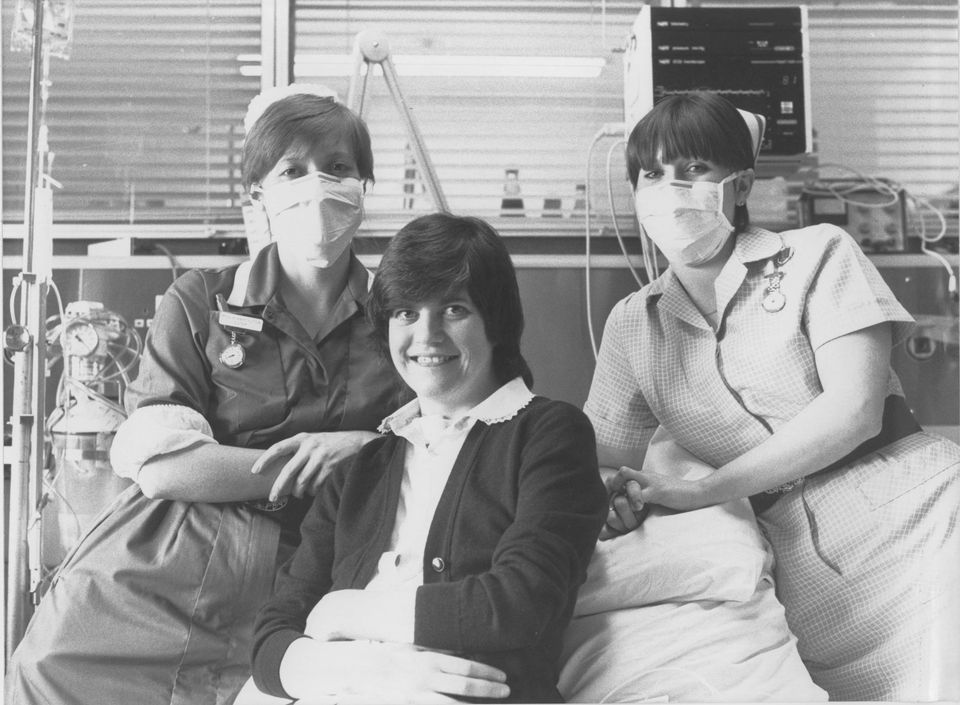Staff who performed Europe’s first successful heart-lung transplant in April 1984 have come together in a special reunion with patients to mark the 40th anniversary.
Brenda Barber was 36 years-old when she underwent the pioneering operation in the early hours of 5 April 1984.
Having been days from death, she became a national celebrity overnight and the first heart-lung recipient in Europe to leave hospital.
Brenda lived for 10 years with her new heart and lungs before dying in 1994.

Our first heart-lung transplant recipient, Brenda (middle) shortly after her pioneering operation in April 1984.
Surgeons, doctors and nurses from Royal Papworth Hospital NHS Foundation Trust – some of whom still work at the hospital – were reunited for a special event held at the hospital on the Cambridge Biomedical Campus.
Staff who contributed to the landmark transplant in 1984, heart-lung transplant patients and current members of our transplant team came together to celebrate the occasion.
Brenda’s operation was carried out by Professor John Wallwork. Then a consultant cardiothoracic surgeon, Professor Wallwork had previously played a part in transplantation history during his time in California as chief resident at Stanford University Hospital, being part of the team who performed the world’s first heart-lung transplant in 1981.
He retired earlier this year after 42 years of NHS service, including the last 10 as Chair of Royal Papworth Hospital NHS Foundation Trust.
Professor John Wallwork
On the pioneering operation, Professor Wallwork said: “The onus was on us to get it right. We’d done our homework and I’d done heart-lung transplants myself before in America.”
“I think to see people who had very poor quality of life or indeed no life to look forward to actually leading a good normal life is just a great thrill,”
“Dealing with someone who's really sick, someone with severe heart or lung failure and they really are breathing their last - they're blown up like a balloon or they're blue. Putting in a new heart or lung, they go pink and they go back to living a normal, active life."
Celia Hyde (left) and Dawn Wheeldon (right) were theatre scrub nurses for the pioneering operation in 1984
Celia Hyde was a theatre scrub nurse that night. She said: “It was such a privilege to be there, to actually see what was going on, to see that empty chest and then to hear that the patient was breathing, speaking and things a few days later. It was absolutely fantastic.”
The 68-year-old said she moved onto working in transplant outpatients, where she cared for Ms Barber after her operation.
She continued, “I think people forget it’s the simple things. It’s like being able to dress yourself, it’s being able to talk and laugh.
“Those are the things that are crucial for us to be happy human beings and I think Brenda went into life thinking ‘I’m a mother, I want to do all of these things’, and she did that with her daughter.”
Dawn Wheeldon, now 80, was also a theatre scrub nurse. She said: “It was a privilege to be there, part of the team, to work with all the people I did and produced a result that gave her back her life really, and the ability to carry on and see her daughter grow up.
“You just don’t know whether it’s all going to go to plan but it did and John Wallwork is a very good teacher and he led the team very well.
“I think if you’ve got confidence in your leader then everything else falls into place.”
Hazel Farren (left) and Maureen Rootes (right) - intensive care sisters from 1984 - with Mr Stephen Large, now consultant cardiothoracic surgeon at Royal Papworth
Hazel Farren was a sister in the intensive care unit in 1984 and cared for Ms Barber immediately after the groundbreaking surgery.
She said: "Being involved in the first successful operation was amazing. It felt like a real leap forward for these people with awful, awful lung disease.
"It was very surreal but I'm very proud to have been involved - it makes you realise what a special job we do."
(r-l) Heart-lung transplant recipients Vicki, Freya, Tineke and Katie with Professor John Wallwork
Former staff at the 40th anniversary reunion were also joined by four patients who have benefitted from the same heart-lung transplant surgery: Katie Mitchell (51), Tineke Dixon (51), Vicki Lee (33) and Freya Potter (18)
Two of them, Katie (37 years) and Tineke (36 years) are among the longest survivors ever in the world.
Katie with her husband Lex
Katie was just 12 when she was told she could go on the waiting list and then got the call in 1987 to say that organs were available.
“I never thought I wouldn't get through it, but if I hadn't had it, I wouldn't probably have lasted the year," she said.
"After transplant, all I wanted to do was be normal - I've done everything to live a normal life.
“Before transplant I couldn't breathe, I couldn't get up the stairs - once you've got the ability to enjoy life, you just make the most of it. I went back to school, got my qualifications and I've always worked.
"I got married, I've gone on lovely holidays and just done everything that everybody else has done."
"I think everyone should be an organ donor - I think the opt-out system is much better than having to sign up. Without donors and their families, none of this could happen - they've saved so many lives."
See more photos from the event.
Organ donation changes lives, and more than ever people need to confirm their decision on the NHS Organ Donor Register. One donor can save up to nine lives, and even more by also donating tissue. More than 7,000 people are currently waiting for an organ transplant in the UK, while on average around 1,400 people donate each year. Simply visit www.organdonation.nhs.uk.
